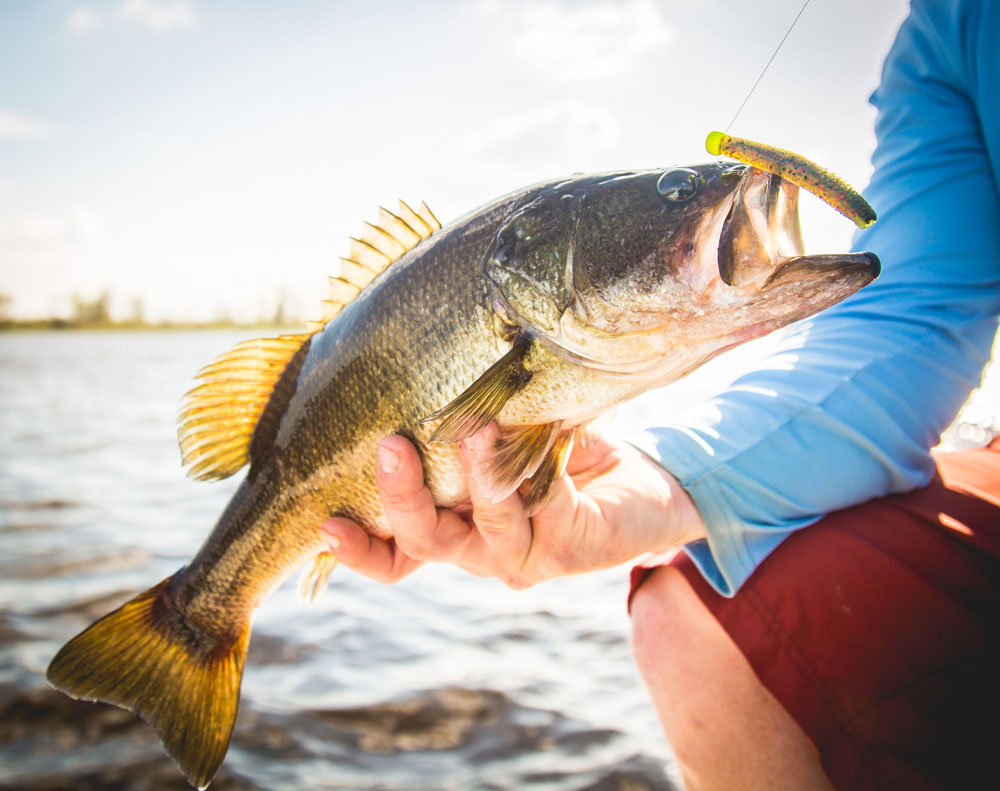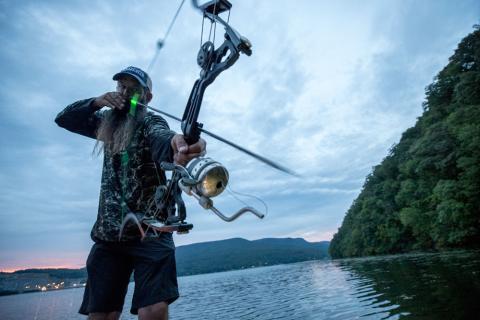provided by John E. Phillips
Thirty-two-year-old Drew Benton from Panama City, Florida, has been tournament fishing for 16 years. He began his tournament fishing career on the FLW Circuit and fished three seasons there, then moved to the Bassmaster Elite Series in 2016 and has qualified for the Bassmaster Classic for 3 years. Drew Benton finished third in the Bassmaster Elite Series Lake Eufaula tournament with 88 anglers on June 13, 2020, catching a total of 82 pounds, 4 ounces of bass to win $20,000.

If I can’t catch hot-weather bass on a dropshot, the last tactic I’ll use is a swimbait. One of the most important keys to remember when you’re fishing a swimbait for bass on deep ledges is you don’t want to let your swimbait drop below the school. You can swim the swimbait over the top of the school of bass or run it through the school. But if you swim it below the school, they will not bite it. I like to fish a Big Bites’ Suicide Shad in the Ayu color, which is shad-colored with a green back. I usually fish this hollow-bellied swimbait on an Owner jig head. My favorite jig head is a 1/2-ounce or 1/4-ounce jig head or a 1-ounce jig head, depending on how deep I’ll fish it. I like either a 5-inch or a 7-inch swimbait. My line will be 20-pound Seagaur Invizx fluorocarbon line with a 7-foot, 7-inch heavy-action Phenix rod with a 6.8:1 gear ratio reel to make sure that I don’t retrieve the swimbait too fast.
Another lure I forgot to mention, mainly because I would only fish this lure during hot weather in the North for smallmouths, is the Ned Rig. If a smallmouth sees a little-bitty Ned Rig hopping around on the bottom, it will eat it. I use it sometimes in the South, so I may have one tied on my casting deck. My favorite Ned Rig color is green-pumpkin on either a 1/5-ounce or a 1/4-ounce jig head. The Ned Rig is fished on some really weird sizes of jig heads - all the way down to a 1/20-ounce. I’ll be fishing the Ned Rig on 15-pound-test braided line and an 8 to 10-pound test fluorocarbon leader that’s about 6-10 feet long on spinning tackle.
Although I rarely fish a Ned Rig in the South, on highland reservoirs, which are deep, clear lakes in the South, like Lewis Smith Lake in Alabama, I will fish a Ned Rig similar to how I would fish a shakyhead jig. One advantage to the Ned Rig is I can get a bass to bite when a shakyhead won’t get a bass to bite. In terms of finesse fishing, the Ned Rig is one step down from the shaky-head worm.
Another lure I must include is the hair jig. When I was fishing Lake Guntersville in Alabama during extremely hot weather, I’ve caught bass on a hair jig when I couldn’t catch any other way. I believe the hair jig is best fished when there’s suspended bass that won’t bite anything else. When you reel a hair jig through the water, the hair sucks in close to the hook and seems to be very compact. But once you kill or stop the jig, all the hair on the jig puffs out and seems to almost float through that segment of the water column where the bass are holding, making it resemble a dying shad. When the shad is swimming, it looks thin, but when a shad stops, you can see its sides, and it looks much bigger.
I fish the hair jig almost the same way I fish a swimbait. I cast it out, count it down to the depth of water where the suspended bass are holding, crank my reel three or four revolutions and next kill the bait. Then I’ll crank the bait again and kill the bait. When I kill the bait, it falls really slowly through a school of bass. I’ve found that this is a subtle presentation that I can use with suspended bass that can get me a bite when nothing else will. I like primarily a white hair jig with some strands of green, blue or black. The hair jigs I’m fishing now are jigs that I make myself. I prefer a 3/8 or a 5/16 jig head and wrap the white buck hair right up against the head of the jig.



























